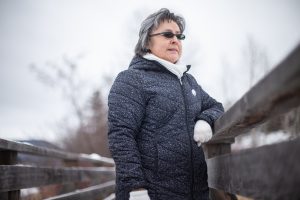Nestled in the rolling aspen parklands of the Touchwood Hills, George Gordon First Nation is about 10 kilometres south of Punnichy, Sask., in Treaty 4 territory. The community was originally founded by Chief Ka-n?wo-kwaskwat?w (George Gordon) and our late great-great-grandfather, Askenootow (Charles Pratt) — who in the 1850s worked for the Anglican Church Mission Society as a lay reader, catechist and school teacher. Pratt built the first day school there in the early 1870s; it was later incorporated into the reserve in 1876. In 1888, this day school became Gordon’s Indian Residential School — the longest-running residential school in Canada. In 1996, 25 years ago, it was the last residential school to close down.
The federal government enlarged the building that Pratt had built and converted it into a boarding school in 1888, before moving the site to its “current location” in 1895. Over the years, despite a fire in 1929, the school grew to include a big brick building with classrooms and a dormitory, horse and cattle barns, poultry and laundry buildings, and staff residences. In 1911, the maintenance and management of the school was handed over to the Anglican church, and it remained under its authority until 1969, when the Indian Department resumed direct responsibility. In time, additional buildings were erected: a new classroom block with a basement auditorium and an additional block with a gymnasium in 1965. The school also boasted a hockey arena and large sports field.
Gordon’s Indian Residential School was originally built on the industrial school model, where most of the children’s time was spent working with livestock, in the large gardens, in the kitchen and laundry, and in housekeeping. Very little time was given to academics, but as the farm was slowly decommissioned, the focus became “residential” — the children got a high school education in addition to doing chores. Students came from Gordon’s reserve — many of them could see their homes from the dormitory building — and from numerous other reserves in Saskatchewan. A few students came from as far away as York Factory and Churchill on the southwestern shores of Hudson Bay in northern Manitoba.
One of the most positive aspects of the school was its robust sports programs, especially hockey. It also had a well-regarded boxing team and a traditional dance troupe that travelled across Europe. Boy Scouts, Girl Guides and other clubs started in the 1960s. The sports and cultural activities gave students a break from the monotony of residential school life and were the most common enjoyable experiences recounted by Gordon’s school survivors.
For many students, however, the extracurricular activities were a double-edged sword. Some participants were victimized by supervisors, staff and principals. Numerous reports of physical and sexual abuse of students go back to the early 20th century. The most notorious sexual abuse crimes were brought to light in a 1992 court case launched by former students against a former director and principal. He was convicted of 10 counts of sexually assaulting boys between the ages of seven and 14 from 1968 to 1984 and admitted to abusing hundreds of young boys over a 40-year period.
The education system at Gordon’s school was not the one envisioned by Chief Ka-n?wo-kwaskwat?w and Askenootow. That generations of their descendants were forced to endure unimaginable pain and hardship is truly a national crime — and the long-term, intergenerational effects of the residential school system are still felt in our communities. The Truth and Reconciliation Commission, Commemoration, and Health and Healing Services —which were created to address numerous court cases and class actions — continue to raise awareness and support community healing activities. At the local level, the George Gordon Recovery and Wellness Centre continues to provide services and support for victims and their families.
The building was demolished not long after the school closed down. All that physically remains of the school is a memorial — incorporating the old school bell, the cross from the roof and the “1929” cornerstone — that was erected in 2008 to honour the students who lived and died there.
Winona Wheeler is an associate professor in the Indigenous Studies Department at the University of Saskatchewan. She is a member of Fisher River Cree Nation in Treaty 5 territory, Man. Her family is from George Gordon’s First Nation in Treaty 4 territory, Sask.




